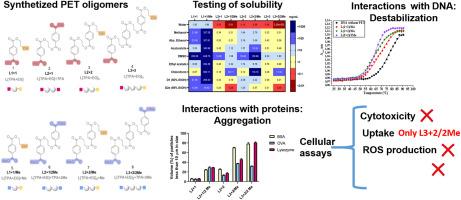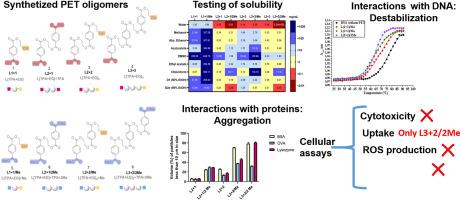Size and end-group chemistry of linear polyethylene terephthalate oligomers matter in chemical risk assessment
IF 7.3
2区 环境科学与生态学
Q1 ENVIRONMENTAL SCIENCES
引用次数: 0
Abstract
Cyclic and linear oligomers, formed as side-products during PET polymerization, are poorly characterized non-intentionally added substances (NIAS) in food. Risk assessment of PET oligomers is challenging due to their size, number, isomerism, complexity in structure, and lack of analytical standards. The great heterogeneity in size and structure of PET oligomers calls for a systematic approach in risk assessment and hazard identification. The aim of our study was to synthesize and characterize physicochemical properties, protein, DNA and cellular interactions of a series of linear methylated and non-methylated PET oligomers (monomer, dimer and trimer). Our results show striking differences in the properties of PET oligomers in relation to size and end-group chemistry (methylated vs. free carboxyl-vs. free hydroxyl-). Solubility in food simulants decreases with increase in methylation and the number of aromatic rings. Linear PET oligomers show little to no toxicity in a wide range of concentrations tested in primary cells and are taken up by human monocyte derived dendritic cells. All linear PET oligomers tested readily interact with food and serum proteins resulting in large protein/plastic oligomer aggregates. Methylated PET trimers bind to salmon sperm DNA, leading to significant destabilization of the DNA. Our results point to the importance of size and end-group of PET oligomers in chemical risk assessment: size and methylation of the oligomer strongly contribute to the observed cellular and molecular effects of tested compounds. Larger methylated PET oligomer binding to DNA prompts further research on the toxicological relevance of the observed interactions.


线性聚对苯二甲酸乙二醇酯低聚物在化学风险评估中的大小和端基化学
在PET聚合过程中作为副产物形成的环状和线性低聚物在食品中是非故意添加物质(NIAS)的特征很差。由于PET低聚物的大小、数量、异构性、结构复杂性和缺乏分析标准,其风险评估具有挑战性。PET低聚物在大小和结构上的巨大异质性要求在风险评估和危害识别方面采用系统的方法。我们的研究目的是合成和表征一系列线性甲基化和非甲基化PET低聚物(单体,二聚体和三聚体)的物理化学性质,蛋白质,DNA和细胞相互作用。我们的研究结果显示,PET低聚物的性质在大小和端基化学(甲基化、游离羧基-和游离羟基-)方面存在显著差异。在食品模拟物中的溶解度随着甲基化和芳香环数量的增加而降低。线性PET低聚物在原代细胞中测试的大范围浓度范围内几乎没有毒性,并且被人类单核细胞来源的树突状细胞吸收。所有测试的线性PET低聚物都很容易与食物和血清蛋白相互作用,导致大量的蛋白质/塑料低聚物聚集。甲基化的PET三聚体与鲑鱼精子DNA结合,导致DNA的显著不稳定。我们的研究结果指出了PET低聚物的大小和端基在化学风险评估中的重要性:低聚物的大小和甲基化对所观察到的被测化合物的细胞和分子效应有很大影响。更大的甲基化PET寡聚物与DNA的结合促使对观察到的相互作用的毒理学相关性的进一步研究。
本文章由计算机程序翻译,如有差异,请以英文原文为准。
求助全文
约1分钟内获得全文
求助全文
来源期刊

Environmental Pollution
环境科学-环境科学
CiteScore
16.00
自引率
6.70%
发文量
2082
审稿时长
2.9 months
期刊介绍:
Environmental Pollution is an international peer-reviewed journal that publishes high-quality research papers and review articles covering all aspects of environmental pollution and its impacts on ecosystems and human health.
Subject areas include, but are not limited to:
• Sources and occurrences of pollutants that are clearly defined and measured in environmental compartments, food and food-related items, and human bodies;
• Interlinks between contaminant exposure and biological, ecological, and human health effects, including those of climate change;
• Contaminants of emerging concerns (including but not limited to antibiotic resistant microorganisms or genes, microplastics/nanoplastics, electronic wastes, light, and noise) and/or their biological, ecological, or human health effects;
• Laboratory and field studies on the remediation/mitigation of environmental pollution via new techniques and with clear links to biological, ecological, or human health effects;
• Modeling of pollution processes, patterns, or trends that is of clear environmental and/or human health interest;
• New techniques that measure and examine environmental occurrences, transport, behavior, and effects of pollutants within the environment or the laboratory, provided that they can be clearly used to address problems within regional or global environmental compartments.
 求助内容:
求助内容: 应助结果提醒方式:
应助结果提醒方式:


